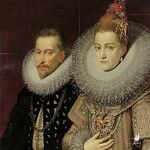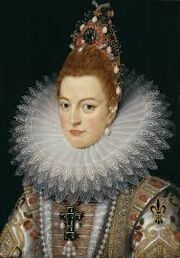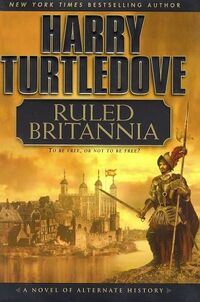"Queen Isabella" redirects here. For the historical Queen Isabella of Castile, see Isabella I of Castile.
| ||||||||||||||||||||||||||||||||||||||||||
Infanta Isabella of Spain (12 August 1566 – 1 December 1633), daughter of King Philip II of Spain, was, with her husband Albert of Austria, joint sovereign of the Hapsburg Netherlands. After her husband's death, she became a nun.
Infanta Isabella in Ruled Britannia

Portrait of Queen Isabella with her husband, King Albert.
Queen Isabella was placed on the throne of England after the Spanish Armada conquered the realm in 1588. She had ancestors from the English House of Lancaster, which gave her a claim on the throne. She married the Austrian Prince Albert, her cousin and fellow Hapsburg, who became King of England through her.[1] Though England was never integrated into the Spanish Crown on paper, Isabella and Albert were completely subservient to her father ruling from Spain.
She restored Catholicism as the kingdom's official state religion, and oversaw the establishment of an English Inquisition and the introduction of Pope Gregory XIII's calendar as tools to enforce Catholic orthodoxy among the English. Her predecessor, Queen Elizabeth, had made Protestantism the official state religion, restoring that status to it after her own predecessor, Queen Mary Tudor had elevated Catholicism following Henry VIII's favouritism of the Protestant sect which he had created over Catholicism.[2] Throughout her monarchy, she was supported by a large Spanish army but was also supported by a sizable English garrison, as well as Irish troops. Isabella also minted silver and copper coins bearing her and her husband's double portrait, though they never displaced completely the old coins bearing Elizabeth's image that still remained in circulation.[3] Isabella's complexion, dark even for a Spaniard, caused many English people to remark on her resemblance to a Moor.[4] Isabella was overthrown in 1598 when the English, under the leadership of Robert Cecil, revolted against her government and restored Elizabeth to the throne.[5] She and Albert narrowly escaped England with their lives.[6]
Isabella was named for her ancestor Queen Isabella of Castile, who had helped unify Spain a century before (and had supported Christopher Columbus' exploratory journey to the New World). During her reign over England, Isabella was in the audience when a play honouring her namesake, written by Spanish soldier and playwright Lope de Vega, debuted.[7]
Literary comment
The marriage of Isabella and Albert occurred in the novel much earlier than in OTL. The novel's afterword explains how their schedule was accelerated by the POD.
See Also
- Infanta Isabella at the Eric Flint Wiki
References
- ↑ Ruled Britannia, pg. 1.
- ↑ Ibid., pg. 5.
- ↑ Ibid, pg. 3
- ↑ See Inconsistencies (Ruled Britannia)
- ↑ Ibid., pgs. 376-394.
- ↑ Ibid., pg. 406.
- ↑ Ibid., pgs. 265-266.
| Royal offices (OTL) | ||
|---|---|---|
| Preceded by Philip II of Spain |
Duchess of Brabant, Limburg, Lothier and Luxembourg; Margravine of Namur; Countess Palatine of Burgundy; Countess of Artois, Flanders, Charolais and Hainaut 6 May 1598 – 13 July 1621 with Albert (6 May 1598 – 13 July 1621) |
Succeeded by Philip IV of Spain |
| Political offices (OTL) | ||
| Vacant Title last held by Archduke Albert of Austria
|
Governor of the Spanish Netherlands 1621–1633 |
Succeeded by Cardinal-Infante Ferdinand |
| Regnal titles (Ruled Britannia) | ||
| Preceded by Queen Elizabeth |
Queen of England with King Albert 1588-1598 |
Succeeded by Queen Elizabeth |
| |||||||||||||||||||

